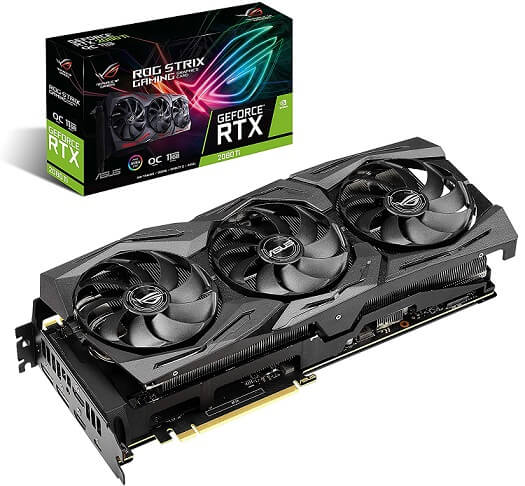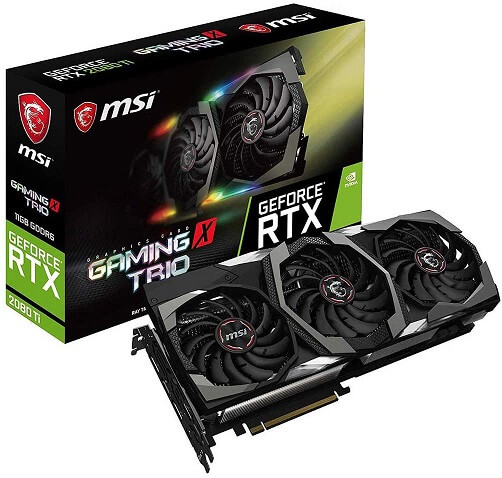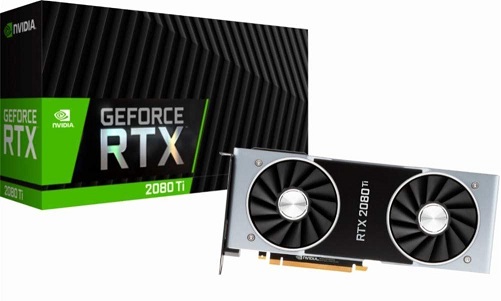Boost Clock: Even though all of the graphics cards present here are RTX 2080 Ti models, they all perform differently. This is primarily due to their different boost clocks which can range from 1500 MHz to 1700 MHz where a higher boost clock offers better gaming performance. VRAM: Another thing to check while buying a graphics card is the VRAM since higher VRAM offers better performance while gaming. Fortunately, since all of these are RTX 2080 Ti cards, all of them have 11 gigs of VRAM. Cooling Fans: Despite having a high boost clock, your graphics card may not perform up to the mark if it is not cooling properly. Hence, it is highly important to check the number of cooling fans. While the founders’ edition card comes with 2 fans, there are also higher-end models with 3 fans with even better cooling.
Best RTX 2080 Ti Graphics Cards 2023
Best RTX 2080 Ti Graphics Cards Reviews
1. ASUS GeForce RTX 2080 Graphics Card
Best RTX 3090 Graphics Card How to Fix Geforce Experience Error Code 0x0003 NVIDIA RTX 3060 Ti Vs. NVIDIA RTX 3070 Best HDMI 2.1 Graphics Card Best RTX 3070 Graphic Cards Best Low Profile Graphics Cards Best RTX 2070 Super Graphics Cards Best 6800 XT Cards
Asus is considered to be one of the most popular brands of computer components that offer various premium components under the ROG Strix lineup including its GPUs. As for the Asus GeForce RTX 2080 Ti ROG Strix GPU, it is one of the best high-end GPUs out there. With this GPU, you get a total of 4352 CUDA cores that have a decent base clock of 1350 MHz and a boost clock of 1665 MHz. While these numbers may not be the highest, you certainly get silent and cool operation thanks to its triple fan design. When combined with its 11 GB video RAM that runs at 14000 MHz memory clock speeds, you can expect gaming performance. With this PCI 3.0 card, you can expect a power consumption of 300 watts or higher at most times. To deliver this power, it uses 2 x 8 pin power connectors. Talking about connectors, you will find 2 x HDMI, 2 x DisplayPort, and 1 x USB Type C ports on the back. Being an Asus GPU, it also comes with AuraSync RGB lighting for various customization options thanks to its versatile companion app. Best Features:
Uses PCI Express 3.0 Bus Comes with 4352 CUDA cores Includes 11 GB GDDR6 VRAM 1350 MHz base and 1665 MHz boost clock Uses 2 x 8 pin power connector 300 watts+ power consumption Cooled by a triple fan design Takes up 2.7x slots Includes AuraSync RGB Lighting Includes 2 x HDMI, 2 x DisplayPort, 1 x USB Type C ports
Pros:
Silent and cool operation Great companion software Offers superb gaming performance
Cons:
Boost clock could have been higher
2. MSI GAMING GeForce RTX 2080 Graphic Card
MSI is one of the biggest competitors to Asus when it comes to computer components since it also makes high-end products like its powerful GPU. With the MSI Gaming X Trio RTX 2080 Ti graphics card, you get an excellent value for money. Despite being the cheapest option here, you get 4352 CUDA cores with it that run at a boost clock speed of up to 1755 MHz which is quite high. And being a Gaming X Trio card, it uses an excellent triple fan design. You also get 352 bit 11 GB VRAM in this graphics card that is necessary for optimal performance while playing ray-traced cards. To offer all these performance numbers, MSI includes 2 x 8 and 1 x 6 power connectors with this PCI 3.0 GPU. While its power consumption may be a bit high, you certainly get excellent connectivity options as it offers 3 x Displayport, 1 x HDMI, and 1 x USB type C on the back. MSI has also managed to include RGB lighting as well as a backplate with this GPU. Best Features:
Uses PCI Express 3.0 Bus Comes with 4352 CUDA cores Includes 11 GB GDDR6 VRAM Rated at 1755 MHz boost clock Uses 2 x 8 and 1 x 6 pin power connector 300 watts+ power consumption Cooled by a triple fan design Takes up 2.5x slots Includes MSI Mystic Lighting Includes 1 x HDMI, 3 x DisplayPort, 1 x USB Type C ports
Pros:
Excellent performance numbers High value for money RTX 2080 Ti Runs pretty cool during operation
Cons:
Uses 3 power connectors
3. NVIDIA GEFORCE RTX 2080 Graphic Card
Other than its board partners, Nvidia also makes its own graphics cards under the Founders Edition lineup that are generally a great value since they sell at MSRP at most times. Unlike previous Founders Edition GPUs, the Nvidia Geforce RTX 2080 Ti Founders Edition offers decent performance numbers. Because its 4352 CUDA cores run at a boost clock of 1635 MHz along with a base clock speed of 1350 MHz, you get similar performance to other higher-end GPUs. This is primarily due to the reason that Nvidia has used a dual-fan design in this FE GPU. Just like other RTX 2080 Ti GPUs, this one also uses 352 bit 11 GB of VRAM that is rated to be GDDR6 for optimal performance. Being a high-performance PCI-E GPU, it is expected to get 2 x 8 pin power connectors with it. Thankfully, its power consumption of 260 watts is quite lower than others. Taking a look at the back, you will find 3 x DisplayPort, 1 x HDMI, and 1 x USB type C which is always great for connecting multiple displays. Best Features:
Uses PCI Express 3.0 Bus Comes with 4352 CUDA cores Includes 11 GB GDDR6 VRAM 1350 MHz base and 1635 MHz boost clock Uses 2 x 8 pin power connector 260 watts+ power consumption Cooled by a dual fan design Takes up 2x slots Includes a light-up logo Includes 1 x HDMI, 3 x DisplayPort, 1 x USB Type C ports
Pros:
Thin and minimal design Low power consumption Decent cooling and performance numbers
Cons:
Fans are a bit loud
4. EVGA GeForce RTX 2080 Graphic Card
Unlike most other GPU brands, EVGA is primarily a GPU brand as it has been offering high-performance graphics cards for a long time including an RTX 2080 Ti. Being a premium brand, the EVGA RTX 2080 Ti XC Ultra Gaming is also a bit on the premium side. And for the given price, you get a total of 4352 CUDA cores inside that all function at a boat clock of 1650 MHz. Unfortunately, since it uses a dual-fan design, the temperatures of this card are not the best. Although, when combined with 352 bit 11 GB VRAM offered by this card and technologies like ray tracing and DLSS, you can expect performance same as most others. This PCIe 3.0 GPU uses 2 x 8 pin connectors with a power consumption of 300 watts which is similar to most others. You also get 3 x HDMI, 1 x HDMI, and 1 x USB type C ports on the back for connecting multiple displays. Best Features:
Uses PCI Express 3.0 Bus Comes with 4352 CUDA cores Includes 11 GB GDDR6 VRAM Rated at 1650 MHz boost clock Uses 2 x 8 pin power connector 300 watts+ power consumption Cooled by a dual fan design Takes up 2.75x slots Includes an RGB Lighting logo Includes 1 x HDMI, 3 x DisplayPort, 1 x USB Type C ports
Pros:
Decent power consumption rating Silent fans even under load Good performance numbers for 4K gaming
Cons:
Not the coolest temperatures
5. Gigabyte AORUS GeForce RTX 2080 Graphics Card
Gigabyte can be another great pick if you are looking for high-end computer components especially if you do not have any budget restrictions and simply want the best. Even though the Gigabyte Aorus RTX 2080 Ti is quite a premium card, its price may be justified for some. This is due to the reason that this 4352 CUDA core card offers the highest boost clocks of 1770 MHz along with very high boost clock speeds of 1545 MHz. All of this is possible thanks to its unique 3 fan design that uses different levels for the fans. As you would expect from a PCIe 3.0 RTX 2080 Ti, it comes with 11 GB VRAM that operates at 14140 MHz. Unfortunately, all of these high-performance numbers come at the cost of a high power usage since it requires a 750 watt PSU to be connected to its 2 x 8 power connectors. A great thing about this premium GPU is that you get 3 x HDMI and 3 x DisplayPort, and 1 x USB Type C ports on the back for excellent connectivity. Best Features:
Uses PCI Express 3.0 Bus Comes with 4352 CUDA cores Includes 11 GB GDDR6 VRAM 1545 MHz base and 1770 MHz boost clock Uses 2 x 8 pin power connector 750 watt PSU recommended Cooled by a triple fan design Takes up 2.75x slots Includes RGB Fusion Lighting Includes 3 x HDMI, 3 x DisplayPort, 1 x USB Type C ports
Pros:
Excellent gaming performance Wide range of connectivity ports Great cooling performance with silent fans
Cons:
Slightly premium RTX 2080 Ti model
Buying Guide for the Best RTX 2080 Ti Graphics Cards
Even if you have decided to get a flagship graphics card like the RTX 2080 Ti, you can still find a wide range of models out there. All of these models offer different performance numbers making it quite difficult to pick the right one. Thus, we have already discussed some of the best RTX 2080 Ti graphics cards above. Along with these various GPUs, you will also find their specifications and features. You can also consider going through this detailed buying guide for the best RTX 2080 Ti graphics cards to choose the right one:
Form Factor
Starting with one of the most overlooked factors to consider while buying a GPU, we have its form factor. The form factor of a GPU primarily given in terms of the number of PCIe slots is going to cover. While most GPUs take up 2 slots, a few high-end models can even take up to 3 slots. This is highly important to consider if you are going to install other expansion cards in your computer along with the GPU.
Core Count
One of the most important factors that affect the performance of your graphics card is the number of cores used by it. Because all of the GPUs present above are RTX 2080 Ti models, they all use 4352 cores. With this many Nvidia CUDA cores, you can expect excellent gaming performance even at 4K.
Clock Speeds
Even though all RTX 2080 Ti GPUs have the same number of CUDA cores, they all offer different performance numbers. This is due to the reason that their cores run at different clock speeds. While checking the clock speed of your GPU, you need to check its base clock and boost clock. These can be simply considered as the minimum and maximum clock speeds of GPUs that are generally around 1400 MHz and 1700 MHz respectively. For the best gaming performance, you can simply get the GPU with the highest boost clock speeds.
Video Memory
While buying a graphics card, you also need to check the amount of video memory offered by it. This becomes even more important if you plan to use multiple monitors at the same time. To ensure that you can enjoy 4K gaming as well as multi-monitor setups with your gaming PC, all RTX 2080 Ti GPUs come with 11 GB of VRAM which is more than enough for most.
Power Consumption
Another factor to consider while getting a graphics card for your computer is the power consumption. Not only does this affect the heat output, but you also need to ensure that the PSU of your computer can handle your graphics card. Usually, you will find most RTX 2080 Ti cards to consume around 300 watts of power. And thus, it is recommended to use a 650 to 750 watt PSU to be on the safe side.
Bus Interface
Your computer’s graphics card gets installed in one of the motherboard’s expansion slots so that it can function properly. But if it is installed in the wrong slot, you will not get optimum performance out of it. Hence, it is highly important to check the bus interface of your GPU and plug it in the right slot. Since all RTX 2080 Ti GPUs use the PCI Express 3.0 bus interface, it is recommended to install your GPU in the topmost PCIe slot for optimum performance.
Ports
All of the monitors of your computer should be connected directly to your graphics card and not the motherboard for optimal performance. Thus, you should check all of the ports offered by your RTX 2080 Ti. Almost all RTX 2080 Ti models include multiple HDMI and DisplayPorts with a few of them even including a USB type C port for connecting all types of devices including VR. With a graphics card that includes multiple ports, you can easily connect multiple monitors at once.
Cooler Type
Just like most other computer components, the graphics card of your computer also gets hot during operation. To get optimum performance out of it, it is highly important to keep it cooled. And speaking of cooling, you can find both water-cooled and air-cooled GPU options out there. As for the RTX 2080, Ti models present above, all of them use an open cooler or air-cooled design which is cheaper and practical for most users.
Number of Fans
If you are going with an open cooler design for your graphics cards, then it is highly important to check the number of fans used by it. This is due to the reason that a GPU with 3 fans is most likely going to have better cooling performance than a 2 fan design. And if your GPU is properly cooled, it will offer optimum gaming performance at all times.
Lighting
Apart from the performance number of your graphics cards, many buyers are also interested in the aesthetics. As a result, almost all GTX 2080 Ti graphics cards come with inbuilt lighting. While the founder’s edition offers a static light-up logo, other cards may even come with RGB lighting which includes a variety of effects for excellent customization options.
Warranty
Whether it is your GPU, CPU, or any other computer component, you would want it to last for as long as possible. Thus, it is always a great idea to check the included warranty period. Usually, you will find GPUs to include at least a 3-year long warranty with a few models including 4 or 5 year long warranty periods which is more than enough. Comment * Name * Email * Website
Δ










![]()